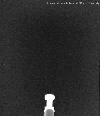Video: Rush Of Gas From A Champagne Bottle
This is a cork popping out of a champagne bottle, as imaged by a high-speed infrared camera. The infrared light...

This is a cork popping out of a champagne bottle, as imaged by a high-speed infrared camera. The infrared light lets you see the plumes of carbon dioxide that shoot out of the bottle’s mouth behind the cork. Carbon dioxide is invisible to the naked eye; the fog you might have noticed around the mouth of opened bottles of fizzy drinks isn’t the carbonation. It’s a combination of water vapor and ethanol vapor.
These photos come from researchers at the University of Reims in the Champagne region of France. They wanted to examine the speed of cork-popping at different temperatures. They found, of course, that corks pop faster out of warmer champagne. At higher temperatures, less of the carbon dioxide in champagne remains dissolved in the liquid. Instead, it lives as a gas in the headspace in the bottle’s neck, creating higher pressures there and thus forcing the cork out faster when you finally open the bottle.
The researchers also found that of all of the energy released when a bottle of Champagne is opened, only five percent contributes to the speedy exit of the cork. The rest of the energy creates an audible shock wave–that festive champagne bang, the researchers think. To be sure, they’re planning to measure the sound waves created by popping bubbly.
Gérard Liger-Belair, a physicist and the lead researcher in the study, tells Popular Science in an email that he wanted “to better understand this rather mythical ‘object’ that a champagne bottle is.” His and his colleagues’ study appeared in the Journal of Food Engineering.